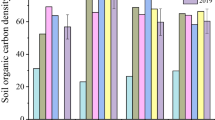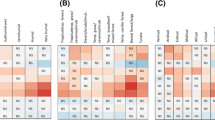Abstract
A variety of soil studies were carried out along a 920-km transect running SE to NW from near the border with northern Nepal, through the Western Tibet Highlands (soils sampled at six locations at an elevation of about 4200 m), to the Takla Makan Desert. This transect, which parallels the China-India border, covers a range of aridities. Annual precipitation decreased exponentially (from 169 mm to ca. 50 mm) north-westwards along the transect. The humidity index also decreased exponentially to the desert zone in the Western Tibet Highlands, and decreased further in the Takla Makan Desert because of the high temperature in the latter area. Vegetation changed fromCaragana thorn-bush steppe, throughArtemisia sparse steppe, to desert. Soil properties were studied in relation to the humidity index. Organic C, total N, cation exchange capacity, and very low C/N ratio values (a maximum of 12.8) of soils decreased with the decrease in humidity index. In contrast, carbonate, pH (KCl), and sulfate increased exponentially. Available P and ammonia content were inversely related to the abundance of carbonate, whereas nitrate increased where carbonate was abundant. Illite was the most abundant of the clay minerals, followed in order by kaolinite and montmorillonite.
Similar content being viewed by others
References
Aomine, S. (1951) Studies on the fixation of ammonium in soils. I. Ammonium fixing-power of some soils in the southwestern provinces of Japan. J. Sci. Soil Manure Jpn.22: 83–87 (In Japanese with English summary).
Brady, N. C. (1974) The nature and properties of soils, 7th ed. 639 pp. Macmillan, New York.
Buol, S. W. &Yesilsoy M. S. (1964) A genesis study of a Mohave sandy loam profile. Soil Sci. Soc. Am. Proc.28: 254–256.
— (1965) Present soil-forming factors and processes in arid and semiarid regions. Soil Sci.99: 45–49.
Central Bureau of Meteorology of China. (1979) Climate atlas of the People's Republic of China, 1st ed. 226 pp. Atlas Publisher Co., Beijing (In Chinese).
Cheng, H., Ni, Z., Sun, S., Yu, X. &Chen, D. (1984) Agricultural geography of Xizang (Tibet), 162 pp. Science Publ. Co., Beijing (In Chinese).
Dregne, H. E. (1976) Soils of arid regions. 230 pp. Elsevier Sci. Publ. Co., Amsterdam.
Gao, Y., Jian, S., Zhangm, Y., Li, J., Lin, Z., Wu, X., Shen, Z., Yuan, F., Huang, C. &Li, C. (1984) Climate of Xizang (Tibet), 300 pp. Science Publ. Co., Beijing (In Chinese).
Hseung, Y. &Jackson M. L. (1952) Mineral composition of the clay fraction: III. of some main soil groups of China. Soil Sci. Soc. Am. Proc.16: 294–257.
Iwatsubo, G., Tsutsumi, T., Kometani, Y. &Hasegawa, Y. (1984) On the spraying of sewage water in a forest (III) Effects of the spraying on soil-nitrogen mineralization and nitrification. J. Jpn. For. Soc.66: 446–453.
—,Yoshimura, F. &Hirabayashi, Y. (1985) On the spraying of sewage water in a forest (IV) An experiment on ammonia volatilization in a greenhouse. J. Jpn. For Soc.67: 471–477.
Kawaguchi, K., Kumada, K., Aomine, S., Kosaka, S., Okajima, H., Sasaki, S., Takai, Y., Yamane, I. &Funabiki, S. (1974) Soil science. 254 pp. Asakura Shoten, Tokyo (In Japanese).
Kawata, H. &Kojima, T. (1979) A method for measuring environmental factors—forest soil. 190 pp. Kyoritsu Shuppan, Tokyo (In Japanese).
Kira, T. (1945) A new classification of climate in Eastern Asia as the basis for agricultural geography, 23 pp. Hort. Inst., Kyoto Univ., Kyoto (In Japanese).
— (1977) A climatological interpretation of Japanese vegetation zones. “Vegetation science and environmental protection. Proceedings of the international symposium in Tokyo on protection of the environmental and excursion on vegetation science through Japan” (ed. Miyawaki, A. & Tüxen, R.), 21–30, Maruzen, Tokyo.
Laboratory for Meteorological Data, Central Bureau of Meteorology of China. (1960) Atlas of Chinese climate (simple edition), 293 pp. Sinhua Publisher, Beijing (In Chinese).
Martin, J. P. &Chapman, H. D. (1951) Volatilization of ammonia from surface-fertilized soil. Soil Sci.71: 25–34.
Martin, W. P. & Fletcher, J. E. (1943) Vertical zonation of great soils on Mt. Graham, Arizona, as correlated with climate, vegetation, and profile characteristics. Arizona Exp. Sta. Tech. Bull. No. 99.
Matsuo, Y. (1968) Improvement of the methods of fertility characteristics determination for the paddy soil samples from Southeast Asia. SE-Asia Study6: 2–112 (In Japanese).
Nanking Institute of Soil Science, Academia Sinica. (1980) Soils of China—their use and improvement, nature of fertility and soil properties, and genesis, classification and distribution. (Trans. from Chinese into Japanese by Kawase, K. & Suganuma, I., 1983), 1020 pp. Hakuyusha, Tokyo.
Negi, A. S. (1980) Quantitative relationships of organic carbon with available nitrogen, phosphorus and potassium in cold desert of Kinnaur (H.P.). Indian J. Agric. Res.14: 1–5.
— &Ghosh, A. S. (1979) Note on the contribution of organic carbon, clay and silt reactions to the cation exchange capacity of the cold desert soil. Indian J. Agric. Res.13: 257–258.
Ohsumi, Y. &Kumada, K. (1971) Studies on alpine soils of Japanese North Alps (1) Morphology and chemical and physical properties of alpine soil. J. Sci. Soil Manure Jpn.7: 44–51 (In Japanese).
Ryan, J. A. &Keeney, D. R. (1975) Ammonia volatilization from surface-applied waste water sludge. J. Water Pollut. Cont. Fed.,47: 386–393.
Stevenson, F. J. (1982) Humus chemistry—Geneisis, composition, reactions, 443 pp. Wiley, New York.
Terry, R. E., Nelson, D. W., Sommers, L. E. &Meyer, G. J. (1978) Ammonia volatilization from waste water sludge applied to soils. J. Water Pollut. Control Fed.50: 2657–2665.
Thompson, L. M. &Troeh, F. R. (1978) Soils and soil fertility. 516 pp. McGraw-Hill, New Delhi.
Thornthwaite, C. W. (1948) An approach towards a rational classification of climate. Georg. Rev.38: 55–94.
Van der Merwe, C. R. &Heystek, H. (1955) Clay minerals of South African soil groups: III. Soils of the desert and adjoining semiarid regions. Soil Sci.80: 479–494.
Wada, K. (1966) Qualitative and quantitative determination of clay minerals. J. Sci. Soil Manure Jpn.37: 9–17 (In Japanese).
Yim, Y. &Kira, T. (1975) Distribution of forest vgetation and climate in the Korean Peninsula. I. Distribution of some indices of thermal climate. Jpn. J. Ecol.25: 77–88.
——, (1976) Distribution of forest vegetation and climate in the Korean Peninsula. II. Distribution of climatic humidity/aridity. Jpn. J. Ecol.26: 157–164.
Author information
Authors and Affiliations
About this article
Cite this article
Iwatsubo, G., Zheng, X. & Shidei, T. An ecological study of soils in the Highlands of western Tibet I. Soils along an iso-altitudinal transect across western Tibet. Ecol. Res. 4, 219–231 (1989). https://doi.org/10.1007/BF02347154
Accepted:
Issue Date:
DOI: https://doi.org/10.1007/BF02347154




